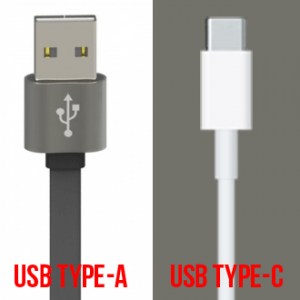The Tech Lover’s Guide to Understanding USB3.1 Type-C
 Chapter 1: What is USB3.1 Type-C
Chapter 1: What is USB3.1 Type-C
USB Type-A ports, that we use for plugging in thumb drives or charging mobile devices, are the current USB standard. It was made popular by the 1998 release of the original iMac. In 2015, however, Apple attempted to set a new standard by replacing the traditional USB Type-A with a USB3.1 Type-C port in its new 12-inch MacBook.
Now, analysts predict USB Type-C will become the new standard because it has two major advantages over traditional USB Type-A.
Advantage #1: Convenience
The 1998 release of USB Type-A was followed by increased popularity of cell phones, which could not fit the popular USB standard. Since cell phones did not have space for a USB Type-A port, each phone manufacturer created its own proprietary micro-USB.
Varying micro-USB styles made buyers need brand-specific micro-USB to USB-Type-A cables for every device. Now, however, Apple seeks to eliminate the need for multiple USB cables with USB Type-C. USB Type-C:
- is small enough to fit cell phones, which eliminates the need for multiple USB cables
- takes up less space, on the side of a computer
- makes charging easier because both ends are identical and USB3.1 Type-C. This means cables can be plugged in from any direction
- may, in the future, eliminate the need for dedicated phone and laptop adapters (see advantage #2 for further clarification).
Advantage #2: Power
 USB Type-C is powerful enough to charge a laptop computer because it can handle up to 100 watts of electricity. This is a huge improvement from USB Type-A, which only has enough power to charge a cell phone.
USB Type-C is powerful enough to charge a laptop computer because it can handle up to 100 watts of electricity. This is a huge improvement from USB Type-A, which only has enough power to charge a cell phone.
The implications of such an advancement are broad. However, the most promising aspect o power increase is the potential to use one cable and adapter for charging laptops and cell phones alike.
Chapter 2: What is USB3.1 Type-C?
Due to the prevalence of USB Type-A, manufacturers have been slow to implement the new USB3.1 Type-C technology. Instead, they have upgraded from USB3.0 to USB3.1. USB3.1 is beneficial because it has transfer speeds of up to 10GBs per second, while the former USB3.0 just operates at 5GBs per second.
The (2016) 12″ MacBook air integrates this speed upgrade from the new USB Type-C. We often refer to it, as second generation USB Type-C or USB3.1 Type-C.
Please, comment, share, and visit our website at MemoryC.com!
Related products:
64GB Transcend JetFlash 890S OTG Flash Drive with USB3.1 and USB3.1 Type-C Connectors
ZTC Sky USB 3.1 Add-On PCIe Card High-Speed Dual C and A USB ports
